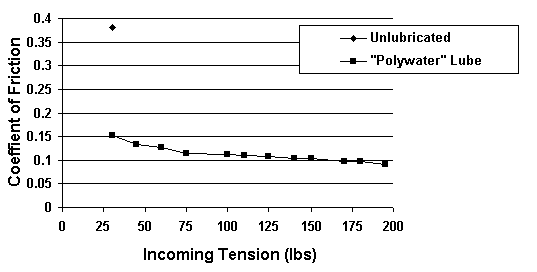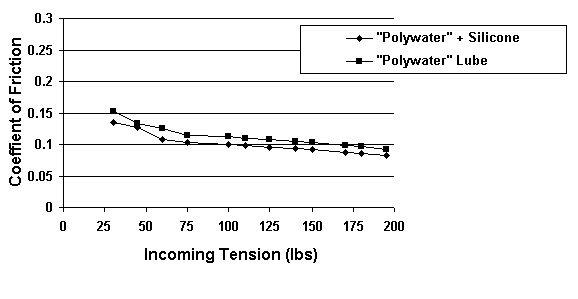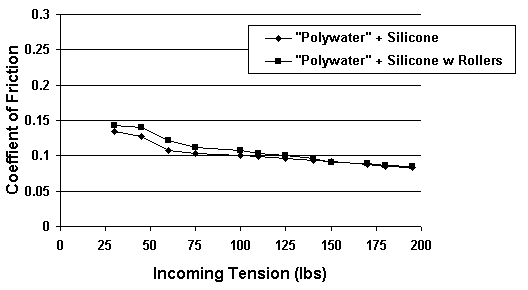| |
|||||||||
| |
|
|
|
|
|
|
|
||
| Home | About | Literature | Site Map | MSDS | Contact | Engineers | Shows | Links | Samples | RFQ | Catalog Numbers |

The practical length of electrical cable pulls has increased significantly over the past 20 years. Innovations in pulling lubricants, and a better understanding of the limitations of cable, have both contributed to this improvement.
Bentonite clay, wax emulsion, and simple polymer/water pulling compounds have been replaced with high performance, multi-polymer lubricants, Polywater® J and Polywater® PJ. Similar improvements in pulling distance have been seen in the installation of communications and fiber optic cable using specialty liquid lubricants like Polywater® F.
Are additional increases in pulling distance possible? Can lubricants be made even better? This "Technical Talk" will measure the effect on friction of several new approaches in lubricant technology.
Slip, Slide, or Roll?
The existing line of Polywater® J High Performance Lubricants is based on patented technologies of water-soluble polymer materials. These lubes are very slippery, but not oily, or based on oil. They maintain their low coefficient of friction with or without water (wet or dry).
One new technology uses non-water soluble polymers (silicone oils) as friction-reducers in pulling compounds. The field performance of "silicone" lubricants has been unpredictable, and good side-by-side studies to determine the benefit of "silicone" have not been available.
A second interesting technology of lubrication uses "mini-rollers" (small spheres). These rollers are intended to function as "bearings" or "wheels" in a lubricant, and to literally roll underneath a cable as it is pulled. "Mini-roller" lubricants have some use in Europe, and small, plastic spheres have been incorporated into some pulling lubricants available in the United States.
Evaluation Method
The primary function of a lubricant is to lower friction and tension in cable pulling. In this evaluation, friction was measured by pulling an XLPE-jacketed cable through a series of multiple bends (six 90° bends--helically wound) in Schedule 40 PVC conduit. Varying drag force was put on the end of the cable (tail weight or incoming tension) and the force required to pull the cable was measured.
The coefficient of friction for the cable/conduit/lubricant can then be calculated from:
COF = 2/5pi x ln(Tout/Tin) Equation #1
Where:
COF = Coefficient of Friction
Tout = Measured Pulling Tension
Tin = Incoming Tension
ln = Natural Log (base e)
The multiple-bend duct test is a variation of a method described previously ¹. The technique uses the multiplier effect of conduit bends and an exponential friction coefficient to produce significant tension differences in short distance pulls
The Lube Factor
Figure 1 shows data from this test. Figure 1 plots friction coefficient versus incoming tension for unlubricated and lubricated cable.

As expected, this graph shows a significant difference between lubricated and unlubricated cable. The unlubricated coefficient of friction is .38 versus the Polywater® J Lubricant range of .09 to .16. Only one data point could be determined for the unlubricated cable because back tensions above 30 lbs. produced forces that tore the jacket off the cable.
Figure 1 shows that the lubricated coefficient of friction went down with increasing back tension. This does not mean that the pulling tension went down with increased back tension. Equation (1) clarifies that the (pulling tension/incoming tension) ratio decreased slightly as the incoming tension increased.
A theoretical explanation for this coefficient of friction variation is beyond the scope of this article. However, this variation has been observed in a number of studies, sometimes camouflaged as lower pulling tension than expected (calculated) in pulls with multiple bends. Figure 1 again shows that coefficient of friction is a range of values rather than a single, absolute number.
Silicone
Figure 2 compares the standard water-based Polywater® J Lubricant (no silicone) to a similar silicone-based lube (similar viscosity, etc.) called Polywater® Plus Silicone™.

Polywater® Plus Silicone™ shows slightly lower friction coefficients than standard Polywater® J. The difference is in the 10 to 15% range. While small, the improvement is consistent throughout the range of incoming tensions.
Rollers
Figure 3 compares the Polywater® Plus Silicone™ from Figure 2 with an identical lube with mini-rollers (average diameter of .6 mm).

The rollers show no benefit, and, in fact, raise the coefficient of friction somewhat at the lower incoming tensions.
The cable pulled with the mini-rollers showed that the balls cut into the cable jacket leaving longitudinal score marks and/or pressed into the jacket forming craters. Under sidewall pressure, the balls didn't act like rollers, but embedded in the jacket instead.
Conclusions
The data above are for a single cable jacket and duct type. However, tests on other types of jackets and duct show similar results. From this we can draw some useful conclusions.
Plain Polywater® J Lube shows an outstanding friction coefficient range of .09 to .16. Less efficient lubes in this same test might show coefficients of .20 to .30. The Polywater® Plus Silicone™ shows an even lower coefficient of friction. On the other hand, the mini-rollers in the lubricant offer no apparent benefit. End-users should be aware of possible scoring and abrading of cable jacket with roller lubes.
Silicone is relatively expensive, as are silicone-based lubes. Is the friction difference worth the added cost? From the data above, there would only be a minor benefit from a silicone lube in a straight pull, where the coefficient is linear and the bearing pressure low (left side of graph). However, the additional tension reduction with the Polywater® Plus Silicone™ could be significant in multiple-bend pulls, where the coefficient is an exponent.
Samples Available
American Polywater's silicone-based lubes are available for testing or purchase. Try them for tough pulls where you feel they may offer a cost benefit. Polywater® Plus Silicone™ is also suitable for use in ducts that are already lined with silicone. Call our sales department at 800-328-9384 to arrange for a trial of Polywater® Plus Silicone™.
¹ See paper entitled "A New Cable Pulling Friction Measurement Technique and Results." Call for copy.
View this article in PDF Format
Click here for free Streaming Videos on cable lubrication and installation
For Subscriptions, Comments, or Questions contact: tkeditor@polywater.com
Home |
About |
Site Map |
Literature |
Samples |
Links |
Reps |
Videos |
Pumps |
RFQ
Codes |
Engineering |
Shows |
Spotlight |
Newsletters |
MSDS |
Translations |
Contacts |
Jobs

11222 60th ST N | Stillwater, MN 55082-9310 USA
1-(651) 430-2270 (Voice) | 1-(651) 430-3634 (Fax)
1-(800) 328-9384 (Toll-Free US/Canada Only)
Copyright © 2001 - 2015 American Polywater Corporation | ![]() 6/5/15
6/5/15